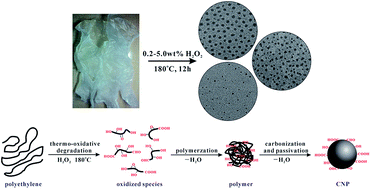Green and size-controllable synthesis of photoluminescent carbon nanoparticles from waste plastic bags†
Abstract
We have developed a facile approach for green and size-controllable synthesis of photoluminescent carbon nanoparticles (CNPs) by hydrothermal treatment of various waste plastic bags (WPBs) in low-concentration H2O2 solutions (≤5.0 wt%). This approach requires no toxic regents, severe synthetic conditions, or complicated procedures. Fine control over the particle size of the CNPs is achieved by simply changing the H2O2 concentration, and higher H2O2 concentration leads to smaller particle size of the CNPs. An interesting formation mechanism of the CNPs derived from WPBs has been proposed including thermo-oxidative degradation, polymerization, carbonization, and passivation. It is found that the CNPs can selectively quantify the concentration of Fe3+ from 10 to 400 μM with a detection limit as low as 2.8 μM. Moreover, the strong photoluminescence, excellent optical stability, low cytotoxicity, and good water-dispersibility of the CNPs make them suitable candidates for cellular imaging. The simple method developed here presents a new way for effective reuse of WPBs and realizes the encouraging “waste-to-treasure” conversion.


 Please wait while we load your content...
Please wait while we load your content...